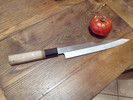- Joined
- Apr 20, 2019
- Messages
- 27
Hello guys, i'm new in this forum.
I wanted to make a yanagiba in n690co but I confused the steel plates I own and now I realized that I used the k110 (aisi d2)
I know it is not the most suitable steel for this type of knife but I am sorry to throw it away, so I would like to proceed with the most suitable heat treatment for this knife and its use. I believe that the goal of ht, in this case, is to obtain the finest grain possible, to improve the stability of the edge. In order to get it, I would like to know what austenitization temperature you recommend and soking time. Also the tempering temperature to obtain an adequate hardness.
As equipment, I have an electric oven with programmabile PID that controls the temperature ramp, and a self-built refrigerating machine that reaches - 78° c(-109F). Sorry for my English, greetings from Italy
I wanted to make a yanagiba in n690co but I confused the steel plates I own and now I realized that I used the k110 (aisi d2)
I know it is not the most suitable steel for this type of knife but I am sorry to throw it away, so I would like to proceed with the most suitable heat treatment for this knife and its use. I believe that the goal of ht, in this case, is to obtain the finest grain possible, to improve the stability of the edge. In order to get it, I would like to know what austenitization temperature you recommend and soking time. Also the tempering temperature to obtain an adequate hardness.
As equipment, I have an electric oven with programmabile PID that controls the temperature ramp, and a self-built refrigerating machine that reaches - 78° c(-109F). Sorry for my English, greetings from Italy

